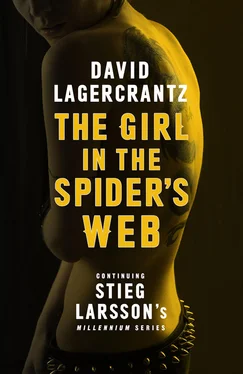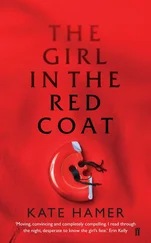“That’s irrelevant,” Svensson insisted.
“Maybe,” Modig said. “Jan and I share your view that the most important thing here is whether it’s in the interests of the investigation to release her name. And as to the investigation, our priority is the boy’s safety, and that’s where we have a big element of uncertainty.”
“I follow your reasoning,” Holmberg said in a low, thoughtful tone which immediately commanded everyone’s attention. “If people know of Salander’s involvement then the boy will be at risk. But that still leaves a number of questions — first: what’s the ethical thing to do? And I have to say, even if there’s been a leak here we cannot accept that Salander should keep the boy hidden away. He’s a crucial part of the investigation and, leak or no leak, we’re better at protecting a child than an emotionally disturbed young woman could ever be.”
“Absolutely. Of course,” Bublanski muttered.
“And even if this isn’t a kidnapping in the ordinary sense — yes, even if it’s been carried out with the best of intentions — the potential harm to the child could be just as great. Psychologically it must be hugely damaging for him to be, as it were, on the run after everything he’s been through.”
“True,” Bublanski said. “But the question still remains: how do we deal with the information we have?”
“There I agree with Curt. We have to release her name and photograph right away. It could produce invaluable leads.”
“Probably,” Bublanski said. “But it could at the same time help the killers. We have to assume that they haven’t given up looking for the boy. Quite the opposite in fact. And since we have no idea what the connection is between the boy and Salander, we don’t know what sort of clues her name would provide them with. I’m not persuaded that we would be protecting the boy by giving the media these details.”
“But neither do we know if we’re protecting him by holding them back,” Holmberg said. “There are too many pieces of the puzzle missing for us to draw any conclusions. Is Salander doing this for someone else, for example? Or does she have her own agenda for the child, apart from to protect him?”
“And how could she have known that Torkel Lindén and the boy would come out onto Sveavägen at that exact moment?” Svensson said.
“Maybe she just happened to be there.”
“Doesn’t seem likely.”
“The truth is often unlikely,” Bublanski said. “That’s the nature of truth. But I agree, it doesn’t feel like a coincidence in this case, not under the circumstances.”
“What about the fact that Mikael Blomkvist also knew something was going to happen?” Amanda Flod said.
“There’s some sort of connection between Blomkvist and Salander,” Holmberg said.
“True.”
“Blomkvist knew that the boy was at Oden’s Medical Centre, didn’t he?”
“The mother told him,” Bublanski said. “As you might imagine, she’s feeling quite desperate now. I’ve just had a long conversation with her. But there was no reason on earth why Blomkvist should have known that Lindén and the boy would be tricked into going out onto the street.”
“Could he have had access to a computer at Oden’s?” Flod said pensively.
“I can’t imagine Mikael Blomkvist getting involved in hacking,” Modig said.
“But what about Salander?” Holmberg said. “What do we actually know about her? We have a massive file on the girl. Yet the last time we had anything to do with her, she surprised us on every count. Maybe appearances are just as deceptive this time around.”
“I agree,” Svensson said. “We have far too many question marks.”
“Question marks are about all we have. And that’s exactly why we ought to stick to the rules,” Holmberg said.
“I didn’t realize the rule book covered quite so much,” Bublanski said, with a sarcasm he regretted.
“I only mean that we should take this for what it is — the kidnapping of a child. They disappeared almost twenty-four hours ago. We haven’t heard a word from them. We should put out Salander’s name and picture and then look carefully at all the tip-offs that come in,” Holmberg said with authority. He seemed to have the backing of the whole group, and at that Bublanski closed his eyes and reflected that he loved them all. He felt a greater affinity with his team than he did for his own brothers and sisters, or even his parents. But right now he felt compelled to disagree with them.
“We’ll do everything we can to try to find them. But for the time being we will not release the name and picture. That would only make the situation more fraught, and I don’t want to risk giving the killers any leads at all.”
“And you feel guilty,” Holmberg said, without warmth.
“I feel very guilty,” Bublanski said, thinking of his rabbi.
Blomkvist was so worried about the boy and Salander that he hardly slept. Time and again he had tried to reach Salander via the Redphone app, but she had not answered. He had not heard a word from her since yesterday afternoon. Now he was sitting in the office, trying to immerse himself in his work and figure out what it was that had escaped him. For some time already he had had a sense — impossible to put his finger on — that there was a key piece missing, something which could shed light on the whole story. Perhaps he was fooling himself. Maybe it was just wishful thinking, a need to see a grand design. The last message from Salander on the encrypted link was:
There were some images of Bogdanov on the net. They showed him wearing pinstriped suits which fit perfectly but still managed to look wrong on him, as if he had stolen them on the way to the photographer’s. Bogdanov had long, lank hair, a pockmarked face and large rings under his eyes and you could just about make out some amateurish tattoos beneath his shirt cuffs. His look was dark, intense and piercing. He was tall, but he cannot have weighed more than sixty kilos.
He looked like an old jailbird, but, most striking, there was something about his body language which Blomkvist recognized from the images on the surveillance cameras at Balder’s place. The man gave the same tattered, rough-edged impression.
There were also interviews he had given as a businessman in Berlin in which he vouchsafed that he had been born more or less on the streets. “I was doomed to end up dead in an alleyway with a needle stuck in my arm. But I managed to pull myself out of the muck. I’m intelligent and I’m one hell of a fighter,” he said. There was nothing in the details of his life to contradict these claims, save for the suspicion that he may not have been raised exclusively through his own efforts. There were clues to suggest he had been given a helping hand by powerful people who had spotted his talent. In a German technology magazine, a security chief at the Horst credit institution was quoted as saying, “Bogdanov has magic in his eyes. He can detect vulnerabilities in security systems like no-one else. He’s a genius.”
So Bogdanov was a star hacker, although the official version had him acting only as a “white hat”, someone who served the good, legal side, who helped companies identify flaws in their I.T. security in exchange for decent compensation. There was nothing in the least suspicious about his company, Outcast Security. The board members were all respectable, well-educated people. But Blomkvist did not leave it at that. He and Zander scrutinized every individual who had had any contact with the company, even partners of partners, and they noticed that somebody called Orlov had been a deputy board member for a short time. This seemed strange, because Vladimir Orlov was no I.T. man, but a minor player in the construction sector. He had once been a promising heavyweight boxer in the Crimea and, judging by the few pictures Blomkvist found online, he looked ravaged and brutal.
Читать дальше












